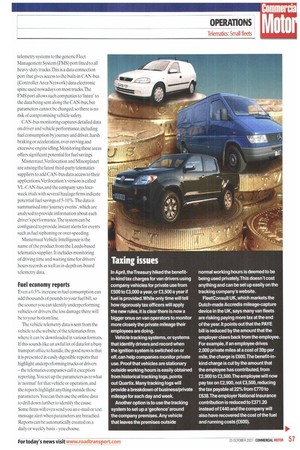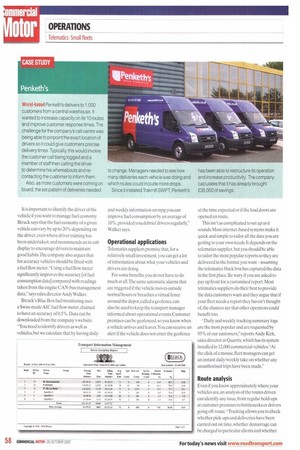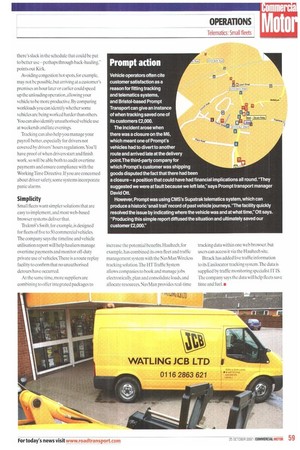O perators of small fleets have often dismissed telematics as being
Page 56

Page 57

Page 58

Page 59

If you've noticed an error in this article please click here to report it so we can fix it.
unsuitable for their operations. Even though fuel is a fleet's largest operating cost. smaller operators have viewed proactive management of fuel economy as too difficult or time-consuming. Tracking has been seen mainly as a theft-prevention device partly because tracking systems were originally marketed as security systems. Now, however, the telematics suppliers are arguing that small and medium-sized fleets that do not monitor fuel use or track their vehicles are missing out on a useful business tool that can help cut excess cost from the operation.
Vehicle and driver telemetry Vehicle manufacturers' own on-board telemetry systems can nearly always offer a wealth of data about vehicle and driver performance an ability that has distinguished them from third-party systems. But that distinction is now blurring, thanks in particular to the access provided by modern on-board telemetry systems to the generic Fleet Management System (FMS) port fitted to all heavy-duty trucks. This is a data connection port that gives access to the built-in CAN-bus (Controller Area Network) data electronic spine used nowadays on most trucks.The FMS port allows such companies to listen' to the data being sent along the CAN-bus, but parameters cannot be changed, so there is no risk of compromising vehicle safety.
CAN-bus monitoring captures detailed data on driver and vehicle performance, including fuel consumption by journey and driver, harsh braking or acceleration, over-revving and excessive engine idling. Monitoring these areas offers significant potential for fuel savings.
Masternaut,Verilocation and Minorplanet are among the latest third-party telematics suppliers to add CAN-bus data access to their applications.Verilocation's version is called VL-CAN-bus, and the company says fourweek trials with several haulage firms indicate potential fuel savings of 5-10°/0.The data is summarised into journey events'. which are analysed to provide information about each driver's performance.The system can be configured to provide instant alerts for events such as fuel siphoning or over-speeding.
Masternaut Vehicle Intelligence is the name of the product from the Leeds-based telematics supplier. It includes monitoring of driving time and waiting time for drivers' hours records as well as in-depth on-board telemetry data.
Fuel economy reports
Even a 0.5% increase in fuel consumption can add thousands of pounds to your fuel bill, so the sooner you can identify underperforming vehicles or drivers, the less damage there will be to your bottom line.
The vehicle telemetry data is sent from the vehicle to the website of the telematics firm, where it can be downloaded in various formats If this sounds like an awful lot of data for a busy transport office to handle, the good news is that it is presented in easily digestible reports that highlight underperforming trucks or drivers —the telematics companies call it exception reporting. You set up the parameters as to what is 'normal' for that vehicle or operation, and the reports highlight anything outside those parameters. You can then use the online data to drill down further to identify the cause. Some firms will even send you an e-mail or text message alert when parameters are breached. Reports can be automatically created on a daily or weekly basis—you choose. It is important to identify the driver of the vehicle if you want to manage fuel economy. Btrack says that the fuel economy of a given vehicle can vary by up to 20% depending on the driver, even where driver training has been undertaken, and recommends an in-cab display to encourage drivers to maintain good habits. The company also argues that for accuracy vehicles should be fitted with a fuel flow meter.Using a fuel flow meter significantly improves the accuracy [of fuel consumption data] compared with readings taken from the engine CAN-bus management data," says sales director Andy Walker.
Btrack's Blue Box fuel monitoring uses a Swiss-made AIC fuel flow meter, claimed to have an accuracy of 0.5%. Data can be downloaded from the company's website. "You need to identify drivers as well as vehicles,but we calculate that by having daily and weekly information on mpg you can improve fuel consumption by an average of 10%, provided you debrief drivers regularly," Walker says.
Operational applications Telematics suppliers promise that, for a relatively small investment, you can get a lot of information about what your vehicles and drivers are doing.
For some benefits, you do not have to do much at all.The same automatic alarms that are triggered if the vehicle moves outside normal hours or breaches a virtual fence around the depot, called a geofence, can also be used to keep the transport manager informed about operational events. Customer premises can be geofenced, so you know when a vehicle arrives and leaves. You can receive an alert if the vehicle does not enter the geofence at the time expected or if the load doors are opened en route.
This isn't as complicated to set up as it sounds. Most internet-based systems make it quick and simple to tailor all the data you are getting to your own needs. It depends on the telematics supplier, but you should be able to tailor the most popular reports so they are delivered in the format you want assuming the telematics black box has captured the data in the first place. Be wary if you are asked to pay up front for a customised report. Most telematics suppliers do their best to provide the data customers want and they argue that if your fleet needs a report they haven't thought ot the chances are that other operators could benefit too.
"Daily and weekly tracking summary logs are the most popular and are requested by 95% of our customers,reports Andy Kirk. sales director at Quartix, which has its system installed in 12,000 commercial vehicles."At the click of a mouse, fleet managers can get an instant daily/weekly take on whether any unauthorised trips have been made.
Route analysis Even if you know approximately where your vehicles are, an analysis of the routes driven can identify any issue, from regular hold-ups at customer premises to bottlenecks or drivers going off-route.-Tracking allows you to check whether pick-ups and deliveries have been carried out on time. whether demurrage can be charged to particular clients and whether there's slack in the schedule that could be put to better use —perhaps through back-hauling," points out Kirk.
Avoiding congestion hot spots, for example, may not be possible,but arriving at a customer's premises an hour later or earlier could speed up the unloading operation, allowing your vehicle toile more productive. By comparing workloads you can identify whether some vehicles are being worked harder than others You can also identify unauthorised vehicle use at weekends and late evenings.
Tracking can also help you manage your payroll better, especially for drivers not covered by drivers' hours regulations. You'll have proof of when drivers start and finish work , so will he able both to audit overtime payments and ensure compliance with the WorkingTime Directive. If you are concerned about driver safety, some systems incorporate panic alarms.
Simplicity
Small fleets want simpler solutions that are easy to implement, and most web-based browser systems deliver that.
Trakrn8's Swift, for example, is designed for fleets of five to 50 commercial vehicles. The company says the timeline and vehicle utilisation report will help hauliers manage overtime payments and monitor off-duty private use of vehicles.There is a route replay facility to confirm that no unauthorised detours have occurred.
At the same time, more suppliers are combining to offer integrated packages to increase the potential benefits. Haultech, for example, has combined its own fleet and traffic management system with the Nav1VIan Wireless tracking solution.The HTTraffic System allows companies to book and manage jobs electronically, plan and consolidate loads, and allocate resources. NavMan provides real-time tracking data within one web browser, but users can access it via the Haultech site.
B track has added live traffic information to its Easilocator tracking system.The data is supplied by traffic monitoring specialist IT IS. The company says the data will help fleets save time and fuel. •


























































































































































































